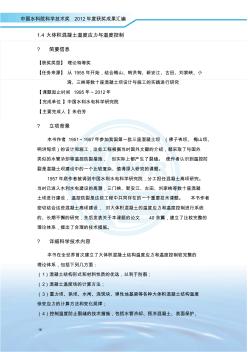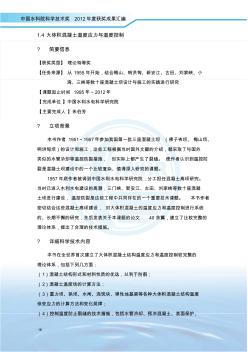Contents
Preface i About the Author v
1 Introduction 1
1.1 The Significance of Thermal Stress in Mass Concrete 1
1.2 The Features of Thermal Stresses in Concrete Structures 3
1.3 The Variation of Temperature and Thermal Stress of Mass Concrete with Time 4
1.3.1 The Variation of Temperature of Mass Concrete with Time 4
1.3.2 The Variation of the Thermal Stress in Mass Concrete 5
1.4 Kinds of Thermal Stress 6
1.5 Analysis of Thermal Stress of a Massive Concrete Structure 6
1.6 Thermal Stress—The Cause of Crack 7
1.7 Technical Measures for Control of Thermal Stress and Prevention of Cracking 8
1.8 The Experience of the Temperature Control and Crack Prevention
2 ConductionofHeatinMassConcrete,BoundaryConditions,andMethodsofSolution11
2.1 DifferentialEquationofHeatConduction,InitialandBoundaryConditions11
2.1.1 DifferentialEquationofHeatConduction11
2.1.2 InitialCondition12
2.1.3 BoundaryConditions13
2.1.4 TheApproximateTreatmentoftheThirdKindofBoundaryCondition14
2.2 SurfaceConductanceandComputationofSuperficialThermalInsulation16
2.2.1 SurfaceConductanceβ16
2.2.2 ComputationoftheEffectofSuperficialThermalInsulation17
2.3 AirTemperature19
2.3.1 AnnualVariationofAirTemperature19
2.3.2 ColdWave19
2.4 TemperatureIncrementsduetoSunshine20
2.4.1 SunRadiationonHorizontalSurface20
2.4.2 TemperatureIncrementoftheDamSurfaceduetoSunshine22
2.4.3 InfluenceofSunshineontheTemperatureofHorizontalLiftSurface22
2.5 EstimationofWaterTemperatureinReservoir25
2.6 NumericalComputationofWaterTemperatureinReservoir28
2.7 ThermalPropertiesofConcrete29
2.8 HeatofHydrationofCementandtheAdiabaticTemperatureRiseofConcrete31
2.8.1 HeatofHydrationofCement31
2.8.2 AdiabaticTemperatureRiseofConcrete32
2.9 TemperatureontheSurfaceofDam35
2.10 TheAutogenousDeformationofConcrete36
2.11 Semi-MatureAgeofConcrete36
2.11.1 MethodforDeterminingtheSemi-MatureAgeofConcrete37
2.11.2 FormulasforComputingtheSemi-MatureAgeofConcrete38
2.11.3 MeaningofSemi-MatureAgeinEngineering40
2.11.4 ExampleoftheInfluenceofSemi-MatureAge40
2.11.5 MeasuresforAdjustingtheSemi-MatureAgesofConcrete41
2.11.6 Conclusions42
2.12 DeformationofConcreteCausedbyChangeofHumidity42
2.13 CoefficientsofThermalExpansionofConcrete43
2.14 SolutionofTemperatureFieldbyFiniteDifferenceMethod44
3 TemperatureFieldintheOperationPeriodofaMassiveConcreteStructure49
3.1 DepthofInfluenceoftheVariationofExteriorTemperatureintheOperationPeriod49
3.1.1 DepthofInfluenceofVariationofWaterTemperature49
3.1.2 DepthofInfluenceofVariationofAirTemperature50
3.2 VariationofConcreteTemperaturefromtheBeginningofConstructiontothePeriodofOperation53
3.3 SteadyTemperatureFieldofConcreteDams54
4 PlacingTemperatureandTemperatureRiseofConcreteLiftduetoHydrationHeatofCement57
4.1 MixingTemperatureofConcrete—T057
4.2 TheFormingTemperatureofConcreteT158
4.3 PlacingTemperatureofConcreteTp60
4.4 TheoreticalSolutionofTemperatureRiseofConcreteLiftduetoHydrationHeatofCement62
4.4.1TemperatureRiseduetoHydrationHeatinConcrete
LiftwithFirstKindofBoundaryCondition4.4.2TemperatureRiseduetoHydrationHeatinConcrete
LiftwithThirdKindofBoundaryCondition 64
4.4.3 TemperatureRiseduetoHydrationHeatwithAdiabaticTemperatureRiseExpressedbyCompoundExponentials66
4.5 TheoreticalSolutionofTemperatureFieldofConcreteLiftduetoSimultaneousActionofNaturalCoolingandPipeCooling67
4.6 TemperatureFieldinConcreteLiftComputedbyFiniteDifferenceMethod69
4.6.1 TemperatureFieldinConcreteLiftduetoHydrationHeatComputedbyFiniteDifferenceMethod69
4.6.2 TemperatureFieldduetoHydrationHeatinConcreteLiftwithCoolingPipeComputedbyFiniteDifferenceMethod70
4.7 PracticalMethodforComputingTemperatureFieldinConstructionPeriodofConcreteDams72
4.7.1 PracticalMethodforComputingTemperatureFieldinConcreteLiftwithoutPipeCooling74
4.7.2 InfluenceofthePlacingTemperatureTpoftheNewConcrete75
4.7.3 PracticalMethodforComputingTemperatureinConcreteLiftwithoutPipeCooling77
4.7.4 PracticalMethodforComputingTemperatureFieldinConcreteLiftwithPipeCooling77
4.7.5 PracticalTreatmentofBoundaryConditionontheTopSurface80
5 NaturalCoolingofMassConcrete83
5.1 CoolingofSemi-InfiniteSolid,ThirdKindofBoundaryCondition83
5.2 CoolingofaSlabwithFirstKindofBoundaryCondition85
5.3 CoolingofaSlabwithThirdKindofBoundaryCondition89
5.4 TemperatureinaConcreteSlabwithHarmonicSurfaceTemperature91
5.4.1 ConcreteSlabwithZeroInitialTemperatureandHarmonicSurfaceTemperature91
5.4.2 ConcreteSlab,InitialTemperatureT0,HarmonicSurfaceTemperature94
5.5 TemperatureinaSlabwithArbitraryExternalTemperature98
5.6 CoolingofMassConcreteinTwoandThreeDirections,TheoremofProduct101
6 Stress-StrainRelationandAnalysisofViscoelasticStressofMassConcrete105
6.1 Stress-StrainRelationofConcrete105
6.1.1 StrainofConcreteduetoConstantStress105
6.1.2 StrainofConcreteduetoVariableStress107
6.1.3 ModulusofElasticityandCreepofConcrete107
6.1.4 LateralStrainandPoisson’sRatioofConcrete110
6.2 StressRelaxationofConcrete111
6.2.1 StressRelaxationofConcreteSubjectedtoConstantStrain111
6.2.2 MethodforComputingtheRelaxationCoefficientfromCreepofConcrete112
6.2.3 FormulasforRelaxationCoefficient114
6.3 ModulusofElasticity,UnitCreep,andRelaxationCoefficientofConcreteforPreliminaryAnalysis115
6.4 TwoTheoremsAbouttheInfluenceofCreepontheStressesandDeformationsofConcreteStructures115
6.5 ClassificationofMassiveConcreteStructuresandMethodofAnalysis117
6.6 MethodofEquivalentModulusforAnalyzingStressesinMaturedConcreteduetoHarmonicVariationofTemperature117
7 ThermalStressesinFixedSlaborFreeSlab121
7.1 ThermalStressesinFixedSlab121
7.1.1 ComputationoftheTemperatureField121
7.1.2 TheElasticThermalStress121
7.1.3 TheViscoelasticThermalStresses123
7.1.4 TheThermalStressesinFixedSlabDuetoHydrationHeatofCement123
7.2 MethodforComputingThermalStressesinaFreeSlab126
7.2.1 ElasticThermalStressinaFreeSlabWhentheModulusofElasticityisConstant126
7.2.2 ViscoelasticThermalStressinaFreeSlabConsideringtheInfluenceofAge128 2100433B

 1.4大体积混凝土温度应力与温度控制简要信息
1.4大体积混凝土温度应力与温度控制简要信息

 大体积混凝土温度应力与温度控制
大体积混凝土温度应力与温度控制